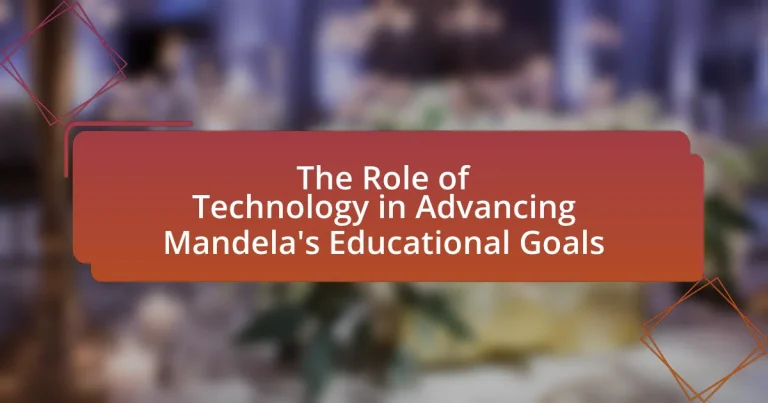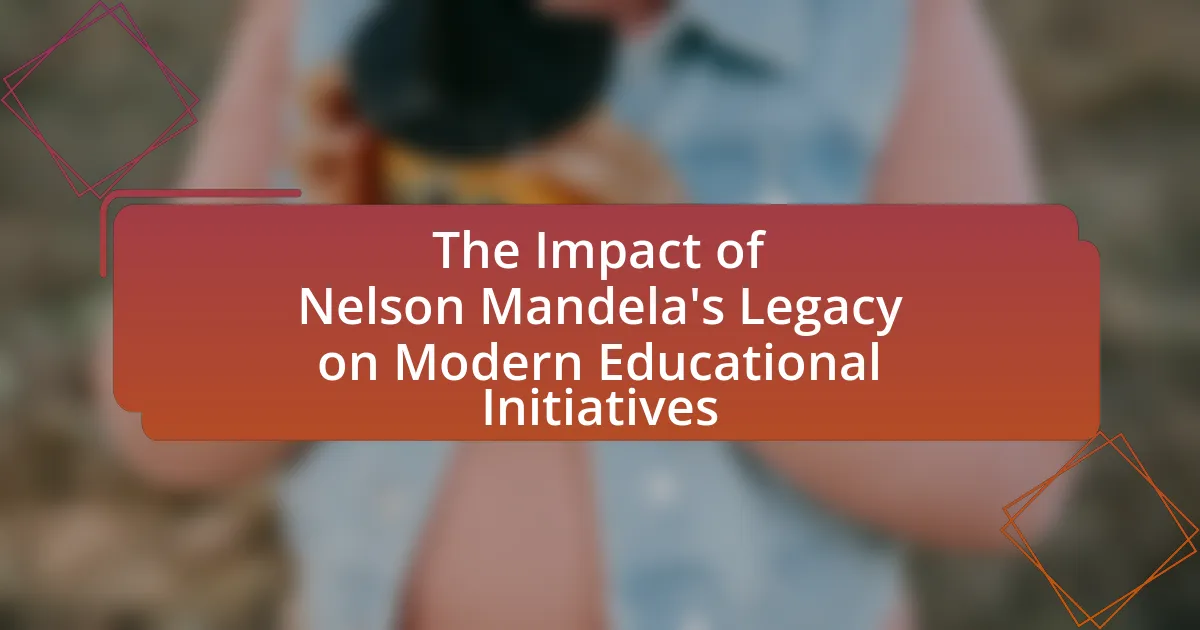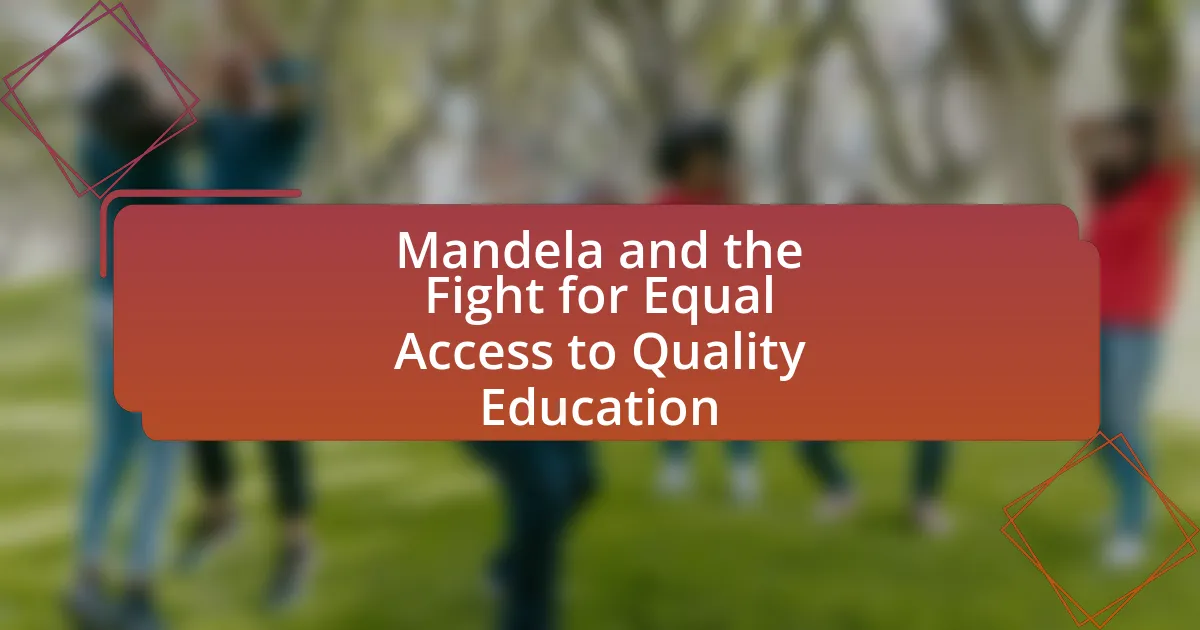The article examines the pivotal role of technology in advancing Nelson Mandela’s educational goals, emphasizing its impact on access to quality education and lifelong learning. It highlights how digital tools and resources facilitate remote learning, particularly for marginalized communities, aligning with Mandela’s vision of education as a means for social change. Key discussions include Mandela’s educational philosophies, the influence of his background, technological advancements since his time, and the challenges and strategies for effectively integrating technology in education. The article also explores future trends in technology that could further enhance educational equity and accessibility, reinforcing Mandela’s commitment to inclusive education.
What is the Role of Technology in Advancing Mandela’s Educational Goals?
Technology plays a crucial role in advancing Nelson Mandela’s educational goals by enhancing access to quality education and promoting lifelong learning. Through the integration of digital tools and resources, technology facilitates remote learning opportunities, making education more accessible to marginalized communities. For instance, initiatives like the use of mobile learning platforms and online courses have expanded educational reach, allowing individuals in rural areas to access quality content that aligns with Mandela’s vision of education as a powerful tool for social change. Furthermore, technology supports interactive learning environments, fostering critical thinking and collaboration among students, which are essential components of Mandela’s educational philosophy.
How did Nelson Mandela envision education as a tool for social change?
Nelson Mandela envisioned education as a fundamental tool for social change by asserting that it is the most powerful weapon to change the world. He believed that education empowers individuals, fosters critical thinking, and promotes social justice. Mandela emphasized that through education, people could challenge oppression and inequality, as evidenced by his statement, “Education is the great engine of personal development.” This perspective is supported by his efforts to expand access to quality education in South Africa, particularly for marginalized communities, which aimed to dismantle the systemic barriers created by apartheid.
What were Mandela’s key educational philosophies?
Nelson Mandela’s key educational philosophies emphasized the transformative power of education, viewing it as a tool for personal and societal change. He believed that education should promote critical thinking, foster social justice, and empower individuals to challenge oppression. Mandela famously stated, “Education is the most powerful weapon which you can use to change the world,” highlighting his conviction that education is essential for achieving equality and freedom. His approach advocated for inclusive education that addresses the needs of marginalized communities, reflecting his commitment to equity and access in learning.
How did Mandela’s background influence his educational goals?
Mandela’s background significantly influenced his educational goals by instilling a strong belief in the power of education as a tool for social change. Growing up in a rural village in South Africa, he experienced firsthand the limitations imposed by apartheid, which fueled his desire to pursue education as a means to uplift his community. Mandela’s exposure to traditional African values and the importance of leadership shaped his commitment to education, leading him to advocate for equal access to learning opportunities for all, particularly for marginalized groups. His educational pursuits were further motivated by his understanding that education could empower individuals to challenge oppressive systems, as evidenced by his later efforts to reform South Africa’s educational policies post-apartheid.
What technological advancements have impacted education since Mandela’s time?
Technological advancements that have impacted education since Mandela’s time include the widespread adoption of the internet, the proliferation of personal computers and mobile devices, and the development of online learning platforms. The internet has transformed access to information, enabling students and educators to connect globally and access vast resources. Personal computers and mobile devices have made learning more interactive and accessible, allowing for personalized education experiences. Online learning platforms, such as Coursera and Khan Academy, have democratized education by providing free or low-cost courses to millions worldwide, aligning with Mandela’s vision of accessible education for all. These advancements have fundamentally changed how education is delivered and experienced, fostering greater inclusivity and engagement.
Which technologies have been most influential in education?
The most influential technologies in education include the internet, learning management systems (LMS), and mobile devices. The internet has revolutionized access to information, enabling students and educators to connect globally and access vast resources. Learning management systems, such as Moodle and Blackboard, facilitate course management, content delivery, and student engagement, streamlining the educational process. Mobile devices, including smartphones and tablets, provide on-the-go access to educational materials and applications, enhancing learning flexibility. According to a report by the International Society for Technology in Education, these technologies have significantly improved student engagement and learning outcomes, demonstrating their critical role in modern education.
How have these technologies changed the learning environment?
Technologies have transformed the learning environment by enhancing accessibility, engagement, and personalization in education. For instance, online learning platforms allow students from diverse backgrounds to access quality educational resources regardless of their geographical location, thereby democratizing education. According to a report by the World Economic Forum, 1.5 billion students were affected by school closures during the COVID-19 pandemic, highlighting the critical role of technology in maintaining educational continuity through remote learning solutions. Additionally, interactive tools such as virtual simulations and gamified learning experiences increase student engagement and motivation, leading to improved learning outcomes. Research from the Bill & Melinda Gates Foundation indicates that personalized learning approaches, facilitated by technology, can significantly boost student achievement by tailoring educational experiences to individual needs.
How does technology facilitate access to education in line with Mandela’s vision?
Technology facilitates access to education in line with Mandela’s vision by providing diverse learning platforms and resources that reach underserved populations. For instance, online learning platforms like Coursera and Khan Academy offer free or low-cost courses, enabling individuals in remote areas to gain knowledge and skills that align with Mandela’s belief in education as a powerful tool for social change. Additionally, mobile technology has expanded access to educational content, with over 5 billion people globally having access to mobile networks, allowing learners to connect with educational resources anytime and anywhere. This aligns with Mandela’s vision of education as a fundamental right, promoting equality and empowerment through accessible learning opportunities.
What role does technology play in bridging educational gaps?
Technology plays a crucial role in bridging educational gaps by providing access to resources and learning opportunities that may not be available in traditional settings. For instance, online learning platforms enable students from remote or underserved areas to access high-quality educational materials and expert instruction, thus reducing disparities in educational attainment. According to a report by the World Bank, the use of technology in education can improve learning outcomes by up to 30%, particularly in low-income regions where educational resources are scarce. This demonstrates that technology not only enhances accessibility but also contributes to improved educational performance, effectively narrowing the gap between different socio-economic groups.
How does online learning enhance accessibility for marginalized communities?
Online learning enhances accessibility for marginalized communities by providing flexible and affordable educational opportunities that can be accessed from anywhere with an internet connection. This mode of learning eliminates geographical barriers, allowing individuals in remote or underserved areas to participate in educational programs that may not be available locally. According to a report by the United Nations Educational, Scientific and Cultural Organization (UNESCO), online education can significantly reduce costs associated with transportation and physical infrastructure, making it a viable option for low-income learners. Additionally, online platforms often offer resources in multiple languages and formats, catering to diverse learning needs and preferences, which further supports inclusivity for marginalized groups.
What are the challenges faced in implementing technology in education?
The challenges faced in implementing technology in education include inadequate infrastructure, lack of training for educators, and resistance to change among stakeholders. Inadequate infrastructure, such as unreliable internet access and insufficient hardware, limits the effective use of technology in classrooms. A study by the International Society for Technology in Education found that 70% of teachers reported needing more professional development to integrate technology effectively. Additionally, resistance to change can stem from fear of technology or a preference for traditional teaching methods, hindering the adoption of innovative educational tools. These factors collectively impede the successful integration of technology in educational settings.
How can technology support inclusive education as advocated by Mandela?
Technology can support inclusive education as advocated by Mandela by providing accessible learning tools that cater to diverse learning needs. For instance, adaptive learning software can personalize educational experiences for students with disabilities, ensuring they receive tailored support. Additionally, online resources and platforms enable remote learning, allowing students from various backgrounds, including those in underprivileged areas, to access quality education. Research indicates that technology-enhanced learning environments can improve engagement and academic performance, particularly for marginalized groups, thereby aligning with Mandela’s vision of equitable education for all.
What tools are available to assist students with disabilities?
Assistive technology tools available for students with disabilities include screen readers, speech-to-text software, and specialized learning applications. Screen readers, such as JAWS and NVDA, enable visually impaired students to access digital content by converting text to speech. Speech-to-text software, like Dragon NaturallySpeaking, allows students with writing difficulties to dictate their thoughts, facilitating easier communication and learning. Additionally, applications like Kurzweil 3000 provide text-to-speech capabilities and study aids, supporting diverse learning needs. These tools are essential in creating an inclusive educational environment, aligning with the goals of equitable access to education.
How does technology promote diversity in educational content?
Technology promotes diversity in educational content by providing access to a wide range of resources that reflect various cultures, perspectives, and learning styles. Digital platforms enable educators to curate and share materials from diverse authors and creators, ensuring that students encounter multiple viewpoints. For instance, online databases and educational apps often include content in multiple languages and formats, catering to learners from different backgrounds. Research indicates that diverse educational content enhances critical thinking and empathy among students, as they engage with materials that challenge their preconceived notions and broaden their understanding of the world.
What are the practical implications of technology in advancing Mandela’s educational goals?
Technology plays a crucial role in advancing Nelson Mandela’s educational goals by enhancing access to quality education and fostering inclusive learning environments. For instance, digital platforms enable remote learning, allowing students in underserved areas to access educational resources and expert instruction, which aligns with Mandela’s vision of education as a tool for empowerment. Furthermore, the integration of technology in classrooms promotes interactive learning experiences, improving student engagement and retention of knowledge. Studies indicate that technology can significantly increase educational outcomes; for example, a report by the World Bank found that the use of educational technology can lead to a 30% improvement in learning outcomes in low-income countries. Thus, the practical implications of technology in education not only support Mandela’s ideals but also provide measurable benefits in learning effectiveness and accessibility.
How can educators effectively integrate technology into their teaching practices?
Educators can effectively integrate technology into their teaching practices by utilizing digital tools and resources that enhance learning experiences and engagement. For instance, incorporating interactive platforms such as Google Classroom or educational apps like Kahoot! allows for real-time feedback and collaborative learning. Research indicates that technology integration can lead to improved student outcomes; a study by the U.S. Department of Education found that technology use in classrooms can increase student engagement and motivation, ultimately enhancing academic performance. By aligning technology with curriculum goals and providing professional development for teachers, educators can create a more dynamic and effective learning environment.
What strategies can be employed to ensure effective technology use in classrooms?
To ensure effective technology use in classrooms, educators should implement strategies such as integrating technology into the curriculum, providing professional development for teachers, and fostering a collaborative learning environment. Integrating technology into the curriculum allows for the enhancement of traditional teaching methods, making lessons more engaging and interactive. Professional development equips teachers with the necessary skills to effectively utilize technology, as studies show that well-trained educators are more likely to incorporate technology successfully into their teaching practices. Additionally, fostering a collaborative learning environment encourages students to work together using technology, which can improve their problem-solving skills and enhance their learning experience. These strategies collectively support the goal of advancing educational outcomes, aligning with Mandela’s vision of accessible and quality education for all.
How can teachers be trained to utilize technology effectively?
Teachers can be trained to utilize technology effectively through structured professional development programs that focus on integrating technology into their teaching practices. These programs should include hands-on training, access to resources, and ongoing support to ensure teachers can confidently implement technology in the classroom. Research indicates that effective training programs, such as those outlined by the International Society for Technology in Education (ISTE), emphasize the importance of pedagogical knowledge alongside technical skills, leading to improved student engagement and learning outcomes.
What best practices can be adopted to maximize the impact of technology in education?
To maximize the impact of technology in education, institutions should adopt a blended learning approach that combines online and face-to-face instruction. This method has been shown to enhance student engagement and improve learning outcomes, as evidenced by a study from the U.S. Department of Education, which found that students in blended learning environments performed better than those in traditional classrooms. Additionally, providing professional development for educators on effective technology integration is crucial; research by the International Society for Technology in Education indicates that teachers who receive training are more likely to implement technology effectively, leading to improved student performance. Finally, ensuring equitable access to technology for all students is essential, as disparities in access can hinder educational equity, a principle aligned with Mandela’s vision for inclusive education.
How can collaboration between educators and tech developers enhance educational outcomes?
Collaboration between educators and tech developers can enhance educational outcomes by creating tailored technological solutions that address specific learning needs. When educators share their insights on classroom challenges, tech developers can design tools that facilitate personalized learning experiences, improve engagement, and streamline administrative tasks. For instance, a study by the Bill & Melinda Gates Foundation found that technology integration, guided by educator input, led to a 20% increase in student engagement and a 15% improvement in academic performance in blended learning environments. This evidence underscores the importance of collaboration in developing effective educational technologies that align with pedagogical goals.
What role do governments and organizations play in supporting educational technology initiatives?
Governments and organizations play a crucial role in supporting educational technology initiatives by providing funding, policy frameworks, and infrastructure development. For instance, many governments allocate budgetary resources specifically for the integration of technology in education, which can be seen in initiatives like the U.S. Department of Education’s “Future Ready Schools” program that aims to equip schools with necessary digital tools. Additionally, organizations such as UNESCO promote global standards and best practices for educational technology, facilitating collaboration among countries to enhance learning outcomes. These efforts are backed by research indicating that increased investment in educational technology correlates with improved student engagement and achievement, as highlighted in the “2019 Horizon Report” by the New Media Consortium, which emphasizes the importance of technology in modern education.
What are the future trends in technology that could further advance Mandela’s educational goals?
Future trends in technology that could advance Mandela’s educational goals include artificial intelligence, personalized learning platforms, and virtual reality. Artificial intelligence can analyze student data to tailor educational experiences, enhancing engagement and effectiveness. Personalized learning platforms, such as adaptive learning software, allow for customized educational paths based on individual student needs, promoting inclusivity and accessibility. Virtual reality can create immersive learning environments, enabling students to experience historical events or complex scientific concepts firsthand, thereby deepening understanding. These technologies align with Mandela’s vision of equitable education by making learning more accessible and engaging for diverse populations.
How might artificial intelligence shape the future of education?
Artificial intelligence will significantly shape the future of education by personalizing learning experiences and enhancing administrative efficiency. AI-driven platforms can analyze individual student performance data to tailor educational content, ensuring that each learner receives customized support that aligns with their unique needs. For instance, a study by the Brookings Institution found that adaptive learning technologies can improve student outcomes by providing targeted interventions based on real-time analytics. Additionally, AI can automate administrative tasks, such as grading and scheduling, allowing educators to focus more on teaching and less on paperwork. This dual impact of personalization and efficiency positions AI as a transformative force in achieving educational goals.
What emerging technologies should educators be aware of?
Educators should be aware of artificial intelligence, virtual reality, and blockchain technology as emerging technologies. Artificial intelligence enhances personalized learning experiences through adaptive learning platforms, which analyze student performance data to tailor educational content. Virtual reality provides immersive learning environments, allowing students to engage with complex subjects in a hands-on manner, thereby improving retention and understanding. Blockchain technology offers secure and transparent credentialing systems, which can streamline the verification of academic achievements and enhance trust in educational qualifications. These technologies are reshaping the educational landscape, aligning with the goals of improving access and quality in education.




